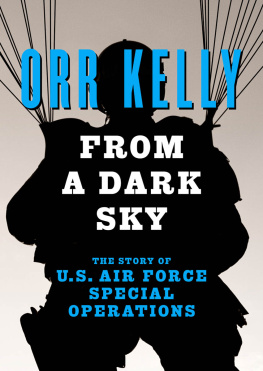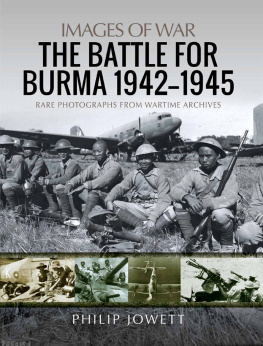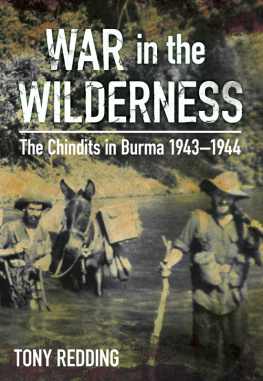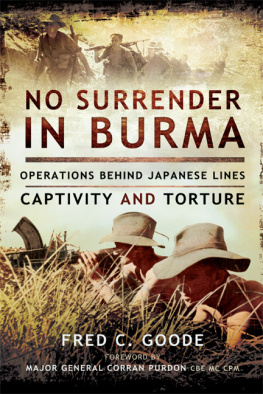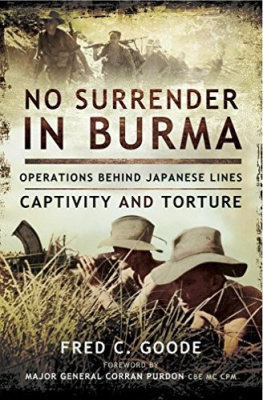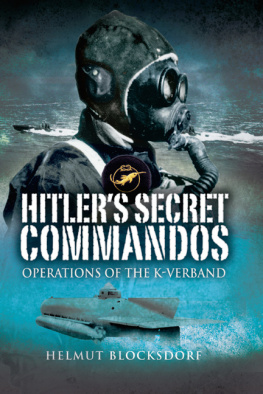

Architects of the Air Commandos: John Alison, Orde Wingate, and Phil Cochran

The latest edition of this work has been brought to publication with the generous assistance of Marguerite and Gerry Lenfest.
Naval Institute Press
291 Wood Road
Annapolis, MD 21402
2008 by the Estate of William T. YBlood
All rights reserved. No part of this book may be reproduced or utilized in any form or by any means, electronic or mechanical, including photocopying and recording, or by any information storage and retrieval system, without permission in writing from the publisher.
ISBN 978-1-61251-579-3 (eBook)
The Library of Congress has cataloged the hardcover edition as follows:
YBlood, William T., 19372006
Air commandos against Japan : Allied special operations in World War II Burma / William T. YBlood.
p. cm.
Includes bibliographical references and index.
1. United States. Army Air Forces. Air Commando Group, 1st. 2. United States. Army Air Forces. Air Commando Group, 2nd. 3. United States. Army Air Forces. Air Commando Group, 3rd. 4. World War, 19391945Aerial operations, American. 5. World War, 19391945CampaignsBurma. 6. World War, 19391945Regimental historiesUnited States. 7. World War, 19391945Commando operationsBurma. 8. Special forces (Military science)United StatesHistory. I. Title.
D790.254.Y35 2008
940.54867309591dc22
2008023338

 Print editions meet the requirements of ANSI/NISO z39.48-1992 (Permanence of Paper).
Print editions meet the requirements of ANSI/NISO z39.48-1992 (Permanence of Paper).
15 14 13 12 11 10 9 8 9 8 7 6 5 4 3 2 1
First printing
Contents
B efore the Japanese attack on Pearl Harbor, American war planners considered campaigns against the three Axis partners and assigned defeating Germany the highest priority. As the Axis aggression grew these plans merged into the Rainbow series for war against a coalition of enemies. The United States would defend the Western hemisphere and fight Japan, while Britain and France battled Germany and Italy. After the fall of France in May 1940, the United States planned to join Britain in defeating Germany while containing Japan. Once Germany was beaten the Allies would direct their attention against Japan. Although never formally ratified, the defeat of Germany first became the unofficial policy of the Allies during World War II.
Regarded as a backwater by many, the ChinaBurmaIndia (CBI) theater was vitally important to the Allies because it tied down 1 million Japanese troops to ensure Chinas isolation. Had Japan prevailed over the British in India and Burma, those Japanese forces might have been redeployed to fight elsewhere in the Pacific. By 1943 the Japanese controlled northern and central Burma, cutting Chiang Kai-sheks Nationalist Chinese forces and Maj. Gen. Claire Chennaults 1st American Volunteer Group, the Flying Tigers, off from their supplies coming through Indian ports. Meanwhile, an airlift known as the Hump Route was begun in late 1942 to fly supplies from Ledo in Assam, five hundred miles over the Himalayas.
In December 1942 the Allies launched an offensive in Burma (the Arakan campaign), but it was beaten back. Outnumbered and outgunned, the British could not hope to match the Japanese in conventional warfare. Moreover, the jungle terrain and adverse weather also favored the Japanese. Enter Britains legendary but quirky Brigadier General Orde C. Wingate, an expert in irregular warfare. Wingate developed the concept of Long-Range Penetration Groups Wingate had organized the 77th Indian Brigade, a three-thousand-man force of British, Gurkha, and Burmese troops called Chindits (a corruption of chinthe) after the mythical creatures who guarded Burmas Buddhist temples. On February 12, 1943, Wingate launched Operation Longcloth, the objective of which was to penetrate Japanese lines.
Transported by air two hundred miles behind the Japanese, this raiding group wreaked havoc with its hit-and-run tactics, sabotaging transportation, especially cutting the MandalayMyitkyina railway line, and otherwise disrupting Japanese lines of communication. But British air resources came up short and failed to provide the support needed, including supplies, reinforcements, and medical evacuation. As a result, nearly 800 members of Wingates force were killed, and of the 2,200 who came back to India, only 600 returned to combat duty. Nonetheless, the operation marked the first instance of taking the fight to the Japanese, and it, thereby, boosted British morale.
Prime Minister Winston Churchill, an admirer of Wingates tactics, invited Wingate to outline his plans to Allied political and military leaders meeting in August 1943 at the Quadrant Conference in Quebec. Among those present at the briefings were President Franklin D. Roosevelt, Gen. George C. Marshall, and Gen. Henry H. Hap Arnold, commanding general of the U.S. Army Air Forces (USAAF). Arnold did not have to be convinced that Wingate needed American air support. He believed in air powers potential to support guerilla warfare and had coined the term air commandos. Arnold offered to provide Wingate with many more aircraft than the Briton could have imagined.
Called to the Pentagon for reassignment, Lt. Col. John R. Alison and Lt. Col. Philip G. Cochran expected to go to where the action wasEurope. But Arnold had other plans for them. He recruited the two hotshot fighter pilots to organize, train, equip, and command the composite air force that would support Wingate. When Cochran and Alison first arrived in India in November 1943, their mission, called Project 9, presumably had top priority. Arnold told them only to be creative. To hell with the paperwork, Arnold said. Go out and fight. On top of everything, Cochran and Alison had to complete their mission within six months so as to avoid operations during Burmas rainy season, which lasted from May to October. Thus, the Japanese would not have time to counterattack before the monsoons inundated the combatants.
Sixty-four years later Maj. Gen. Johnny Alison, USAF (Ret.), recalled with amazement how he and Cochran created the 1st Air Commandos. At first, many supply and personnel officers simply refused to cooperate, telling Alison, Everybody has a number-one priority. Only after the he and Cochran obtained letters signed by Arnold himself did the two airmen get their equipment, including a variety of aircraft for their composite air forcefighters, bombers, transports, gliders, and even experimental helicopters. In all they assembled an air commando force of more than five hundred men and some 350 aircraft. There were no manuals on how to establish air commandos, but Alison knew he would succeed. As a member of Chennaults Flying Tigers, Alison had flown over the Japanese lines many times.
Next page


